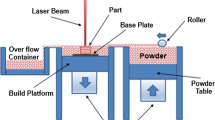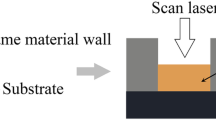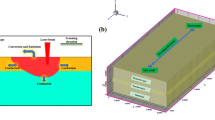Abstract
Selective laser melting (SLM) is a promising metal additive manufacturing technology, which holds widespread applications in numerous fields. Unfortunately, it is arduous to predict the real geometry of SLM part, which impedes its further development, while the morphology of melt pool, influenced and determined by process parameters, poses a crucial influence on the overall part geometry. Nonetheless, the association between process parameters and melt pool morphology is still unclear. Hence, it is indispensable to explore relevant solution to address this issue. For this purpose, this paper proposes a new model to directly establish the mathematical relationship between process parameters and melt pool structure for SLM process. In this model, the status of melt pool is first qualitatively analyzed via the defined synthetic process index, and three types of melting states are differentiated including low melting, intermediate melting, and high melting, which could cover different melt pool modes. Then, the computational model involving more physical mechanisms integrating mass conversion, heat exchange, and temperature field is constructed. Melt pool critical geometries including the height, width, depth, and length could be computed through the model. In order to validate the correctness of the proposed model, published experimental observations and existing models are compared. Calculation results from the proposed model show high consistency with the experimental samples and better accuracy than existing empirical models. Its applicability in melt pool classification and prediction is also verified, laying foundation for geometric simulation of SLM object which is successively shaped melt-pool by melt-pool.










(adapted from Scime and Beuth [9]) of IN718. a Severe keyhole defect. b Normal morphology (all graphs are presented at the same size scale)

(adapted from Yang et al. [28]) of TC4. a Severe keyhole defect. b Normal morphology. c Balling defect (all graphs are presented at the same size scale)

(adapted from Kamath et al. [30]) of 316L. a Normal morphology. b Slightly balling (all graphs are presented at the same size scale)
Similar content being viewed by others
Abbreviations
- \(a\) :
-
Thermal diffusivity (m2/s)
- \(A\) :
-
Maximum cross-sectional area of melt pool (m2)
- \({A}_{g}\) :
-
Contact area between melt pool and gas interface (m2)
- \({A}_{s}\) :
-
Contact area between melt pool and solid interface (m2)
- \(C\) :
-
Material specific heat capacity (J/(kgK))
- \({C}_{l}\) :
-
Liquid specific heat capacity (J/(kgK))
- \({C}_{s}\) :
-
Solid specific heat capacity (J/(kgK))
- \({C}_{lackfusion}\) :
-
Critical normalized enthalpy of lack of fusion
- \(d\) :
-
Melt pool depth (m)
- \(D\) :
-
Laser beam diameter (m)
- \({E}_{i}\) :
-
Specific internal energy of melt pool (J/kg)
- \({E}_{s}\) :
-
Specific internal energy of solidification melt pool (J/kg)
- \(h\) :
-
Melt pool height (m)
- \({H}_{\mathrm{sl}}\) :
-
Melting enthalpy (J/m3)
- \(\Delta H/{H}_{\mathrm{sl}}\) :
-
Normalized enthalpy
- \(k\) :
-
Thermal conductivity (W/(mK))
- \(K\) :
-
Temperature gradient (K/m)
- \(l\) :
-
Melt pool length (m)
- \({L}_{t}\) :
-
Layer thickness (m)
- \(P\) :
-
Laser beam power (W)
- \({Q}_{gc}\) :
-
Convection energy between melt pool and gas environment (J)
- \({Q}_{gr}\) :
-
Radiation energy between melt pool and environment (J)
- \({Q}_{sc}\) :
-
Conduction energy between melt pool and solid environment (J)
- \(t\) :
-
Time (s)
- \(T\) :
-
Transient melt pool temperature (K)
- \({T}_{b}\) :
-
Material boiling temperature (K)
- \({T}_{m}\) :
-
Material melting temperature (K)
- \({T}_{o}\) :
-
Initial temperature (K)
- \({T}_{ms}\) :
-
Steady-state melt pool temperature (K)
- \(v\) :
-
Scanning speed (m/s)
- \(V\) :
-
Melt pool volume (m3)
- \(w\) :
-
Melt pool width (m)
- \({\alpha }_{g}\) :
-
Thermal convection coefficient (W/(m2K))
- \({\alpha }_{s}\) :
-
Equivalent thermal convection coefficient (W/(m2K))
- \({\beta }_{h/d}\) :
-
Melt pool shape ratio of height to depth
- \({\beta }_{l/w}\) :
-
Melt pool shape ratio of length to width
- \({\beta }_{w/d}\) :
-
Melt pool shape ratio of width to depth
- \(\varepsilon\) :
-
Thermal radiation coefficient
- \(\eta\) :
-
Absorptivity of solid material
- \({\eta }^{*}\) :
-
Absorptivity of powder material
- \(\lambda\) :
-
Steady-state melt pool temperature coefficient
- \({\lambda }_{melting}\) :
-
Melting degree index
- \({\mu }_{HM}\) :
-
Critical coefficient of high melting state
- \({\mu }_{IM}\) :
-
Critical coefficient of intermediate melting state
- \({\mu }_{defect}^{keyhole}\) :
-
Critical coefficient of over-melting state
- \({\mu }_{defect}^{lackfusion}\) :
-
Critical coefficient of under-melting state
- \(\rho\) :
-
Material density (kg/m3)
- \({\rho }_{p}\) :
-
Material density of powder state (kg/m3)
- \({\rho }_{s}\) :
-
Material density of solid state (kg/m3)
- \(\sigma\) :
-
Stefan-Boltzmann constant (W/(m2K4))
- \(\tau\) :
-
Ratio of laser exposure time to thermal diffusion time
References
King WE, Barth HD, Castillo VM, Gallegos GF, Gibbs JW, Hahn DE, Kamath C, Rubenchik AM (2014) Observation of keyhole-mode laser melting in laser powder-bed fusion additive manufacturing. J Mater Process Tech 214(12):2915–2925. https://doi.org/10.1016/j.jmatprotec.2014.06.005
Liu B, Fang G, Lei L (2021) An analytical model for rapid predicting molten pool geometry of selective laser melting (SLM). Appl Math Model 92:505–524. https://doi.org/10.1016/j.apm.2020.11.027
Han X, Zhu H, Nie X, Wang G, Zeng X (2018) Investigation on selective laser melting AlSi10Mg cellular lattice strut: molten pool morphology, surface roughness and dimensional accuracy. Materials 11(3):392. https://doi.org/10.3390/ma11030392
Gu D, Shi X, Poprawe R, Bourell DL, Setchi R, Zhu J (2021) Material-structure-performance integrated laser-metal additive manufacturing. Science 372(6545). https://doi.org/10.1126/science.abg1487
Seede R, Shoukr D, Zhang B, Whitt A, Gibbons S, Flater P, Elwany A, Arroyave R, Karaman I (2020) An ultra-high strength martensitic steel fabricated using selective laser melting additive manufacturing: densification, microstructure, and mechanical properties. Acta Mater 186:199–214. https://doi.org/10.1016/j.actamat.2019.12.037
Wang Q, Michaleris PP, Nassar AR, Irwin JE, Ren Y, Stutzman CB (2020) Model-based feedforward control of laser powder bed fusion additive manufacturing. Addit Manuf 31:100985. https://doi.org/10.1016/j.addma.2019.100985
Doumanidis C, Kwak YM (2001) Geometry modeling and control by infrared and laser sensing in thermal manufacturing with material deposition. J Manuf Sci Eng 123(1):45–52. https://doi.org/10.1115/1.1344898
Wang Q (2019) A control-oriented model for melt-pool volume in laser powder bed fusion additive manufacturing. Dyn Syst Control Conf Am Soc Mech Eng 59148:V001T10A002. https://asmedigitalcollection.asme.org/DSCC/proceedings/DSCC2019/59148/V001T10A002/1070481
Scime L, Beuth J (2019) Melt pool geometry and morphology variability for the Inconel 718 alloy in a laser powder bed fusion additive manufacturing process. Addit Manuf 29:100830. https://doi.org/10.1016/j.addma.2019.100830
Scime L, Beuth J (2019) Using machine learning to identify in-situ melt pool signatures indicative of flaw formation in a laser powder bed fusion additive manufacturing process. Addit Manuf 25:151–165. https://doi.org/10.1016/j.addma.2018.11.010
Papadakis L, Loizou A, Risse J, Bremen S, Schrage J (2014) A computational reduction model for appraising structural effects in selective laser melting manufacturing: a methodical model reduction proposed for time-efficient finite element analysis of larger components in Selective Laser Melting. Virtual Phys Prototyp 9(1):17–25. https://doi.org/10.1080/17452759.2013.868005
Francis ZR (2017) The effects of laser and electron beam spot size in additive manufacturing processes. Dissertation, Carnegie Mellon University
Bertoli US, Wolfer AJ, Matthews MJ, Delplanque JPR, Schoenung JM (2017) On the limitations of volumetric energy density as a design parameter for selective laser melting. Mater Design 113:331–340. https://doi.org/10.1016/j.matdes.2016.10.037
Rubenchik AM, King WE, Wu SS (2018) Scaling laws for the additive manufacturing. J Mater Process Tech 257:234–243. https://doi.org/10.1016/j.jmatprotec.2018.02.034
Mirkoohi E, Sievers DE, Garmestani H, Chiang K, Liang SY (2019) Three-dimensional semi-elliptical modeling of melt pool geometry considering hatch spacing and time spacing in metal additive manufacturing. J Manuf Process 45:532–543. https://doi.org/10.1016/j.jmapro.2019.07.028
Tang M, Pistorius PC, Beuth JL (2017) Prediction of lack-of-fusion porosity for powder bed fusion. Addit Manuf 14:39–48. https://doi.org/10.1016/j.addma.2016.12.001
Promoppatum P, Yao SC, Pistorius PC, Rollett AD (2017) A comprehensive comparison of the analytical and numerical prediction of the thermal history and solidification microstructure of Inconel 718 products made by laser powder-bed fusion. Engineering 3(5):685–694. https://doi.org/10.1016/J.ENG.2017.05.023
Eagar TW, Tsai NS (1983) Temperature fields produced by traveling distributed heat sources. Weld J 62(12):346–355. http://files.aws.org/wj/supplement/WJ_1983_12_s346.pdf
Mukherjee T, Zuback JS, De A, DebRoy T (2016) Printability of alloys for additive manufacturing. Sci Rep 6(1):1–8. https://doi.org/10.1038/srep19717
Shrestha S, Chou K (2021) An investigation into melting modes in selective laser melting of Inconel 625 powder: single track geometry and porosity. Int J Adv Manuf Tech 114:3255–3267. https://doi.org/10.1007/s00170-021-07105-3
Yap CY, Chua CK, Dong ZL (2016) An effective analytical model of selective laser melting. Virtual Phys Prototy 11(1):21–26. https://doi.org/10.1080/17452759.2015.1133217
Foroozmehr A, Badrossamay M, Foroozmehr E, Golabi SI (2016) Finite element simulation of selective laser melting process considering optical penetration depth of laser in powder bed. Mater Design 89:255–263. https://doi.org/10.1016/j.matdes.2015.10.002
Cannon JR (1984) The one-dimensional heat equation. Cambridge University Press, Cambridge
Gladush GG, Smurov I (2011) Physics of laser materials processing: theory and experiment. Springer Science & Business Media
Andreotta R, Ladani L, Brindley W (2017) Finite element simulation of laser additive melting and solidification of Inconel 718 with experimentally tested thermal properties. Finite Elem Anal Des 135:36–43. https://doi.org/10.1016/j.finel.2017.07.002
Cheng B, Lydon J, Cooper K, Cole V, Northrop P, Chou K (2018) Melt pool sensing and size analysis in laser powder-bed metal additive manufacturing. J Manuf Process 32:744–753. https://doi.org/10.1016/j.jmapro.2018.04.002
Le TN, Lo YL, Lin ZH (2020) Numerical simulation and experimental validation of melting and solidification process in selective laser melting of IN718 alloy. Addit Manuf 36:101519. https://doi.org/10.1016/j.addma.2020.101519
Yang J, Han J, Yu H, Yin J, Gao M, Wang Z, Zeng X (2016) Role of molten pool mode on formability, microstructure and mechanical properties of selective laser melted Ti-6Al-4V alloy. Mater Design 110:558–570. https://doi.org/10.1016/j.matdes.2016.08.036
Yadroitsev I, Krakhmalev P, Yadroitsava I (2014) Selective laser melting of Ti6Al4V alloy for biomedical applications: temperature monitoring and microstructural evolution. J Alloys Compd 583:404–409. https://doi.org/10.1016/j.jallcom.2013.08.183
Kamath C, El-Dasher B, Gallegos GF, King WE, Sisto A (2014) Density of additively-manufactured, 316L SS parts using laser powder-bed fusion at powers up to 400 W. Int J Adv Manuf Tech 74(1):65–78. https://doi.org/10.1007/s00170-014-5954-9
Gusarov AV, Yadroitsev I, Bertrand P, Smurov I (2009) Model of radiation and heat transfer in laser-powder interaction zone at selective laser melting. J Heat Transfer 131(7):072101. https://doi.org/10.1115/1.3109245
Balbaa MA, Ghasemi A, Fereiduni E, Elbestawi MA, Jadhav SD, Kruth JP (2021) Role of powder particle size on laser powder bed fusion processability of AlSi10Mg alloy. Addit Manuf 37:101630. https://doi.org/10.1016/j.addma.2020.101630
Khairallah SA, Martin AA, Lee JR, Guss G, Calta NP, Hammons JA, Nielsen MH, Chaput K, Schwalbach E, Shah MN, Chapman MG, Willey TM, Rubenchik AM, Anderson AT, Wang YM, Matthews MJ, King WE (2020) Controlling interdependent meso-nanosecond dynamics and defect generation in metal 3D printing. Science 368(6491):660–665. https://doi.org/10.1126/science.aay7830
Tolochko NK, Khlopkov YV, Mozzharov SE, Ignatiev MB, Laoui T, Titov VI (2000) Absorptance of powder materials suitable for laser sintering. Rapid Prototyp J 6(3):155–160. https://doi.org/10.1108/13552540010337029
Yadroitsev I, Gusarov A, Yadroitsava I, Smurov I (2010) Single track formation in selective laser melting of metal powders. J Mater Process Tech 210(12):1624–1631. https://doi.org/10.1016/j.jmatprotec.2010.05.010
Plotkowski A, Kirka MM, Babu SS (2017) Verification and validation of a rapid heat transfer calculation methodology for transient melt pool solidification conditions in powder bed metal additive manufacturing. Addit Manuf 18:256–268. https://doi.org/10.1016/j.addma.2017.10.017
Zhao Y, Koizumi Y, Aoyagi K, Wei D, Yamanaka K, Chiba A (2019) Molten pool behavior and effect of fluid flow on solidification conditions in selective electron beam melting (SEBM) of a biomedical Co-Cr-Mo alloy. Addit Manuf 26:202–214. https://doi.org/10.1016/j.addma.2018.12.002
Ge W, Han S, Fang Y, Cheon J, Na SJ (2017) Mechanism of surface morphology in electron beam melting of Ti6Al4V based on computational flow patterns. Appl Surf Sci 419:150–158. https://doi.org/10.1016/j.apsusc.2017.05.033
Wei HL, Mukherjee T, Zhang W, Zuback JS, Knapp GL, De A, DebRoy T (2021) Mechanistic models for additive manufacturing of metallic components. Prog Mater Sci 116:100703. https://doi.org/10.1016/j.pmatsci.2020.100703
Dunbar AJ, Denlinger ER, Gouge MF, Michaleris P (2016) Experimental validation of finite element modeling for laser powder bed fusion deformation. Addit Manuf 12:108–120. https://doi.org/10.1016/j.addma.2016.08.003
Dai D, Gu D, Ge Q, Li Y, Shi X, Sun Y, Li S (2020) Mesoscopic study of thermal behavior, fluid dynamics and surface morphology during selective laser melting of Ti-based composites. Comp Mater Sci 177:109598. https://doi.org/10.1016/j.commatsci.2020.109598
Waqar S, Sun Q, Liu J, Guo K, Sun J (2021) Numerical investigation of thermal behavior and melt pool morphology in multi-track multi-layer selective laser melting of the 316L steel. Int J Adv Manuf Tech 112(3):879–895. https://doi.org/10.1007/s00170-020-06360-0
Funding
This research is funded by the National Natural Science Foundation of China (grant number 52005021).
Author information
Authors and Affiliations
Contributions
Kai Guo: conceptualization, methodology, investigation, visualization, writing–original draft. Lihong Qiao: conceptualization, methodology, writing–review and editing, supervision. Zhicheng Huang: methodology, writing–review and editing, supervision, project administration. Nabil Anwer: writing–review and editing, supervision. Yuda Cao: writing–review and editing.
Corresponding author
Ethics declarations
Ethics approval
Not applicable.
Consent to participate
Not applicable.
Consent for publication
Not applicable.
Competing interests
The authors declare no competing interests.
Additional information
Publisher's note
Springer Nature remains neutral with regard to jurisdictional claims in published maps and institutional affiliations.
Appendices
Appendix 1. Material properties for IN718, TC4, and 316L
Appendix 2. Fitting constant values for IN718, TC4, and 316L
Appendix 3. Adopted energy absorptivity under different machines and process conditions for IN718, TC4, and 316L
Rights and permissions
About this article
Cite this article
Guo, K., Qiao, L., Huang, Z. et al. A computational model of melt pool morphology for selective laser melting process. Int J Adv Manuf Technol 121, 1651–1673 (2022). https://doi.org/10.1007/s00170-022-09366-y
Received:
Accepted:
Published:
Issue Date:
DOI: https://doi.org/10.1007/s00170-022-09366-y




